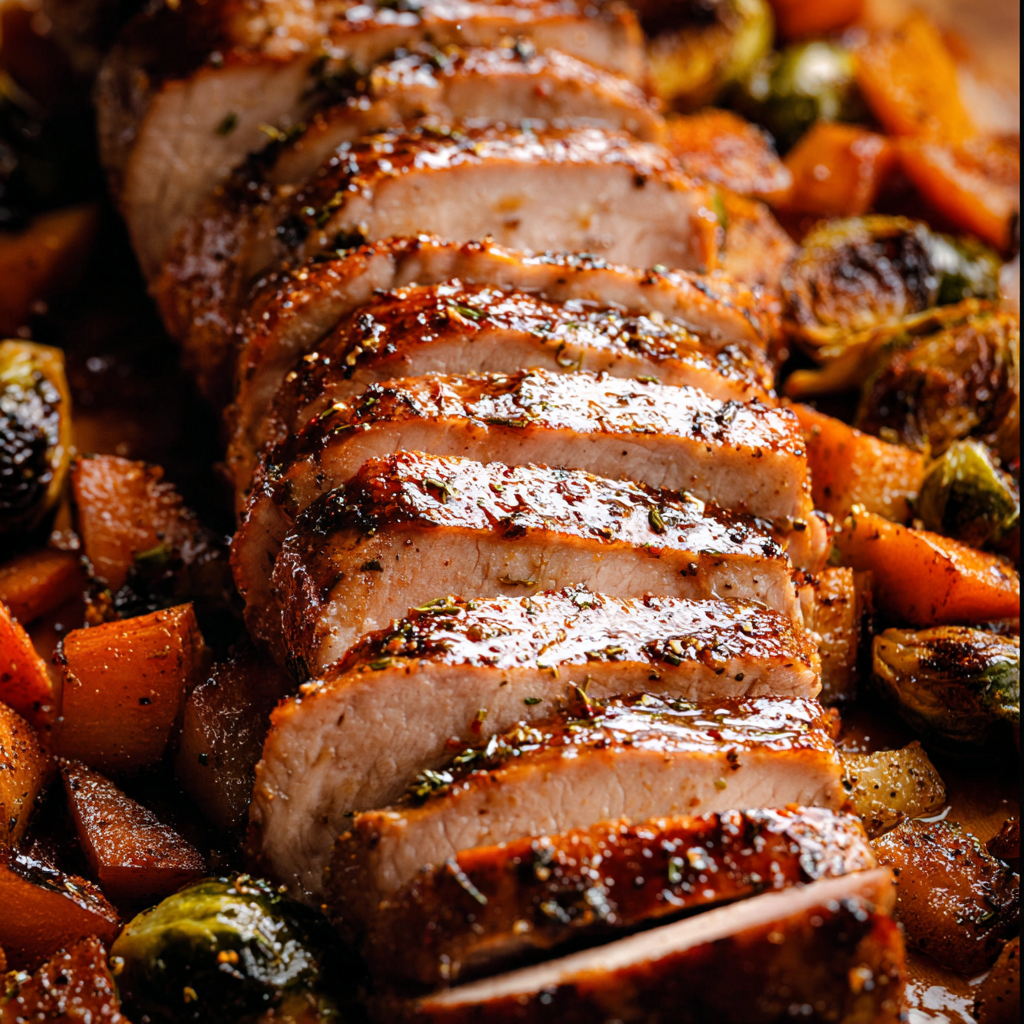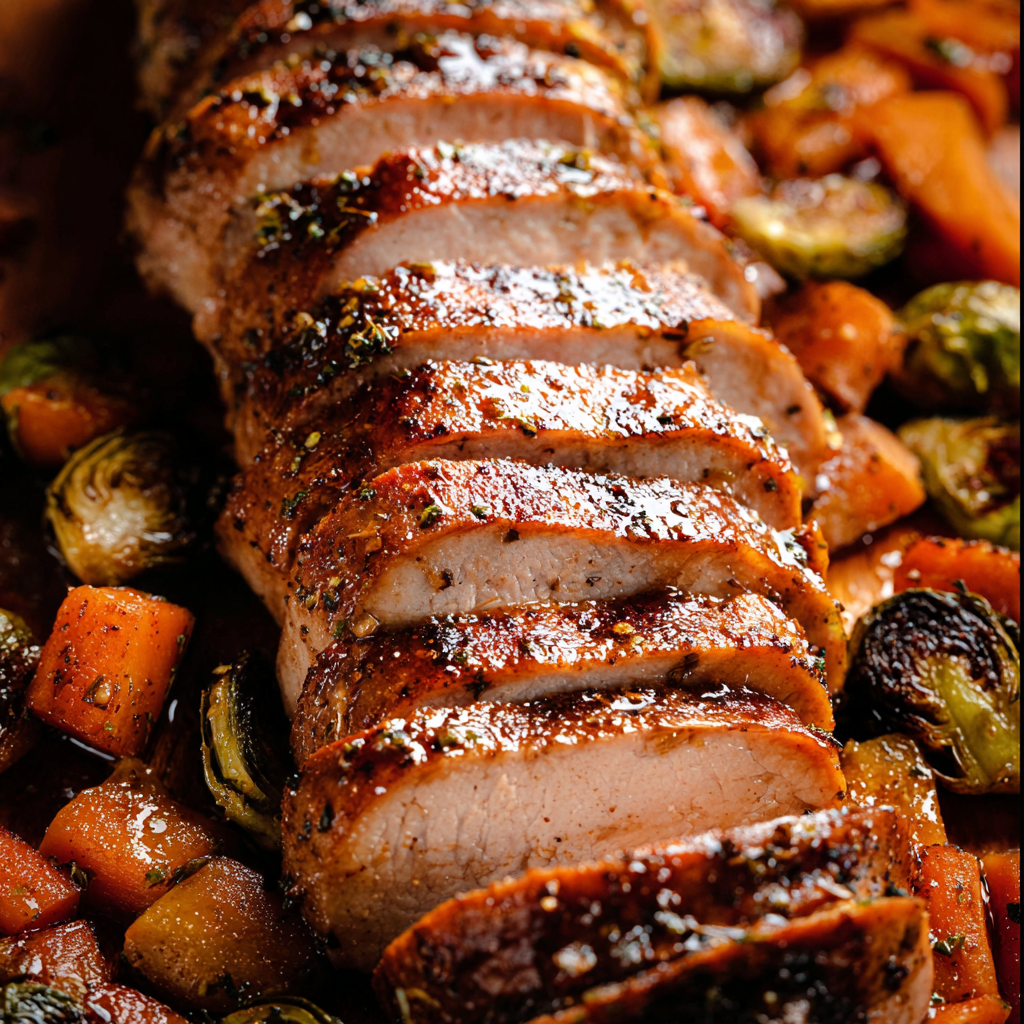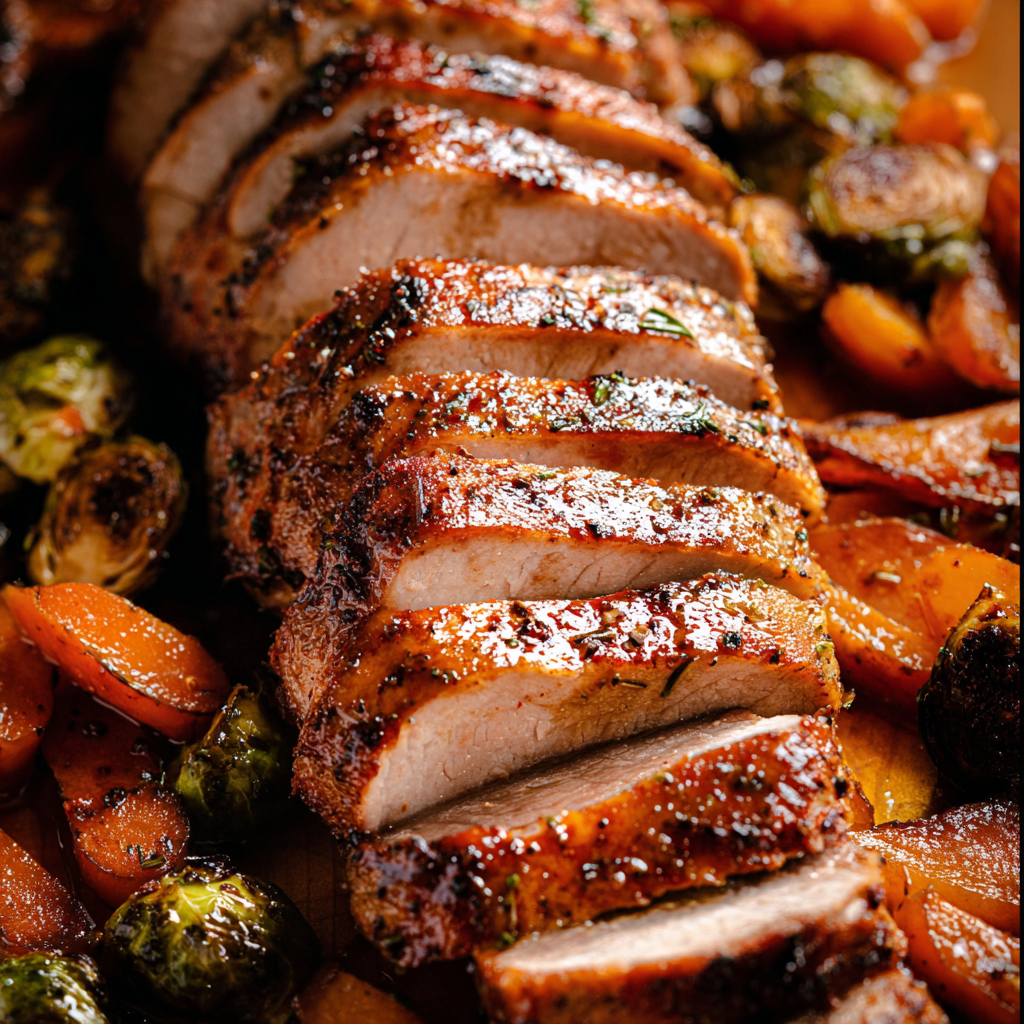1. Introduction to the Recipe
Creating a tender and juicy pork loin roast recipe is one of the most satisfying culinary experiences, especially when you’re after a dish that is both elegant and simple enough for any home cook. Pork loin is naturally lean, which makes it a healthy and versatile protein, but it requires the right preparation to avoid becoming dry. This recipe uses a fragrant blend of herbs and spices and a sticky, glossy honey garlic glaze to create a beautifully balanced roast that is juicy, tender, and incredibly flavorful. Add some roasted brussels sprouts and butternut squash, and you have a complete meal that is vibrant, hearty, and suitable for both everyday dinners and celebratory occasions.
To gain a deeper understanding of the techniques involved, it’s useful to explore additional resources. For example, learning how to sear meat properly can transform your roasting results—browse this helpful guide: https://www.seriouseats.com/how-to-sear-meat. You can also dive into the differences between various pork cuts to help improve your butchery knowledge here: https://www.pork.org/cuts/pork-loin/. These insights help build confidence and set you up for success while preparing the recipe.
With its golden crust, layered flavors, and melt-in-your-mouth tenderness, this roast stands out as one of the most reliable and crowd-pleasing dishes you can make. In this article, you’ll find the complete recipe, thoughtful cooking notes, advanced chef techniques, storage guidance, dietary adjustments, frequently asked questions, and final reflections to help you master every step. Whether you’re a beginner or an experienced cook, this comprehensive guide will walk you through creating a spectacular pork loin roast that shines on any table.
2. Basic Recipe: Ingredients and Instructions
Print
Tender and Juicy Pork Loin Roast Recipe with Honey Garlic Glaze
Description
This tender and juicy pork loin roast recipe features a rich honey garlic glaze and perfectly roasted vegetables for effortless flavor.
Ingredients
For the Pork Loin
- 3-pound pork loin
- 1 tablespoon olive oil
For the Spice Rub
- 1 teaspoon sweet paprika
- 1 teaspoon garlic powder
- 1/2 teaspoon onion powder
- 1/2 teaspoon dried thyme
- 1/2 teaspoon dried rosemary
- Salt and fresh ground pepper, to taste
For the Honey Garlic Glaze
- 4 cloves garlic, minced
- 1/4 cup honey
- 3 tablespoons low-sodium gluten-free soy sauce
- 1 tablespoon Dijon mustard
- 1 tablespoon olive oil
For the Vegetables
- 1 tablespoon olive oil
- 1 pound brussels sprouts, halved
- 1 pound butternut squash, cut into 1-inch cubes
Instructions
- Preheat the oven to 375°F (190°C). Line a roasting pan with parchment paper or lightly grease it.
- Mix the spice rub by combining paprika, garlic powder, onion powder, thyme, rosemary, salt, and pepper.
- Dry the pork loin, rub it with olive oil, and coat it with the spice mixture.
- Optional: Sear pork in a hot skillet for 2–3 minutes per side for deeper flavor.
- Make the glaze by whisking honey, soy sauce, Dijon mustard, garlic, and olive oil.
- Prepare the vegetables by tossing them with olive oil, salt, and pepper. Spread evenly on the pan.
- Place the pork loin in the center, brushing half of the glaze on top.
- Roast for 45–60 minutes, brushing with more glaze halfway through. Cook to 145°F (63°C).
- Rest for 10 minutes, then slice and serve with vegetables.
Notes
Resting the pork ensures juiciness—it’s essential.
If the glaze browns quickly, lightly tent with foil.
Switch up vegetables seasonally for fresh variety.
3. Tender and Juicy Pork Loin Roast, Advanced Techniques
Perfecting the Sear for Maximum Flavor
Searing the pork loin before roasting is a crucial advanced technique that dramatically enhances flavor. When the pork hits a hot pan, the natural sugars and proteins caramelize in what is known as the Maillard reaction. This creates a deep, complex crust that adds depth and contrast to the tenderness inside. For best results, pat the pork dry thoroughly, heat your skillet until nearly smoking, and avoid moving the meat too early—let it brown undisturbed. A proper sear takes 2–3 minutes per side. This step not only improves flavor but also helps the glaze cling better during roasting.
Maximizing Flavor Absorption Through Marination
Marinating the pork loin overnight infuses the meat with deeper flavor and improves tenderness. Because pork loin is lean, marinating helps its fibers relax and retain moisture during cooking. Combine olive oil, herbs, garlic, and a splash of the honey glaze and let the pork soak for 8–12 hours. Place it in a sealed bag with air removed for full contact. This step is especially helpful if you plan to skip searing, because the marinade helps create a similar depth of flavor. It also ensures consistent seasoning throughout the meat, not just on the surface.
Temperature Staging for Even Cooking
To prevent uneven cooking—a common issue with pork loin—let the meat sit at room temperature for 20–30 minutes before roasting. This allows the interior to gradually warm, reducing the temperature difference between the center and exterior. Pair this with a meat thermometer for accuracy. Pull the roast from the oven immediately at 145°F (63°C), as carryover heat will raise it slightly during resting. Proper temperature staging produces evenly cooked pork that remains moist rather than overdone at the edges.
Enhancing the Glaze with Layered Sweetness
The honey garlic glaze is delicious as-is, but advanced cooks can elevate it by layering different types of sweetness. Try adding a touch of molasses, brown sugar, or pure maple syrup to create more caramel complexity. You can also use a bold honey variety like buckwheat honey for deeper flavor. Simmering the glaze in a saucepan for 2–3 minutes thickens it, helping it adhere better and creating a lacquered finish during roasting. Brush the glaze in thin layers rather than all at once for the best caramelization.
Optimizing Vegetable Caramelization
To achieve beautifully caramelized vegetables, ensure they are spread out in a single layer with plenty of airflow between pieces. Moisture is the enemy of browning, so avoid overcrowding the pan. Toss vegetables lightly in oil—too much oil prevents crisping—and season well with salt and pepper. Position the vegetables near the pan’s edges where heat is strongest. Stir once halfway through roasting to brown all sides evenly. These small adjustments lead to deeply flavored, golden vegetables that complement the pork perfectly.

4. Storage, Shelf Life, and Maintenance Tips
Storing Leftover Pork Loin in the Refrigerator
Leftover pork loin stays fresh for 3–4 days in the fridge when stored in an airtight container. Slice the pork before storing, as this helps keep it from drying out. Add a spoonful of glaze or broth to the container to maintain moisture. Store vegetables separately to prevent texture loss. When reheating, do so slowly at low heat to keep the meat tender and juicy.
Freezing Cooked Pork for Long-Term Storage
For longer storage, freeze cooked pork loin slices tightly wrapped in plastic and stored in a freezer-safe bag. Removing excess air helps prevent freezer burn. Frozen pork retains quality for up to 3 months. Thaw overnight in the refrigerator, then reheat gently with a splash of broth or glaze. Freeze vegetables separately since they soften more during thawing.
Maintaining Vegetable Texture After Cooking
Roasted vegetables can lose crispness in the fridge, but proper storage helps preserve it. Place vegetables in a sealed container with a paper towel to absorb moisture. Reheat in an air fryer or skillet for best texture. Avoid freezing unless necessary, as thawing often makes them mushy.
Keeping the Glaze Fresh for Future Meals
Unused glaze stores well in a glass jar for up to one week in the refrigerator. You can also freeze glaze in ice cube trays for easy portion control. Reheat gently on the stove and use it to glaze chicken, salmon, or vegetables. Storing the glaze separately maintains its smooth texture and prevents over-thickening.
Preventing Dryness When Reheating Pork
To maintain juiciness, reheat pork at 300°F (150°C) in a covered dish with added broth or glaze. Steam helps rehydrate the meat. If microwaving, use 50% power in short bursts to avoid overcooking. These simple tactics restore tenderness and preserve moisture.

5. Dietary Adaptations and Substitutions
Gluten-Free Modifications
This recipe becomes fully gluten-free by choosing certified GF soy sauce or tamari. Double-check spice mixes and Dijon mustard for hidden gluten. Because roasted vegetables are naturally gluten-free, this dish easily adapts to gluten-sensitive diets without sacrificing flavor.
Low-Sugar Variation
For reduced sugar, decrease honey or use sugar-free alternatives like monk fruit syrup. The glaze will still caramelize beautifully. Replace sweeter vegetables with low-carb options such as broccoli or cauliflower if aiming for ultra-low sugar.
Dairy-Free Adjustments
Since the recipe is already dairy-free, no major substitutions are needed. Verify that your Dijon mustard contains no dairy derivatives. If serving with creamy sides, use dairy-free substitutes like olive oil or coconut milk.
Low-Sodium Adaptation
Use low-sodium soy sauce and scale back added salt in the rub. Fresh herbs help amplify flavor without adding sodium. When reheating, use unsalted broth to keep the overall dish healthy and balanced.
Paleo-Friendly Version
Swap soy sauce for coconut aminos, ensure mustard is paleo-compliant, and keep honey as your natural sweetener. Serve with non-starchy vegetables for a full paleo meal. These simple tweaks keep the dish rich and flavorful while meeting paleo guidelines.

6. FAQs About the Recipe
Why Did My Pork Loin Turn Out Dry?
Dryness typically results from overcooking. Using a meat thermometer ensures precision—145°F (63°C) is the cutoff for juicy pork. Letting the pork rest afterward redistributes juices. Smaller roasts cook faster, so keep an eye on timing. Adding leftover glaze or broth during reheating restores moisture if needed.
Can I Use Pork Tenderloin Instead of Pork Loin?
You can, but pork tenderloin cooks much faster due to its smaller, thinner shape. Reduce roasting time to 20–25 minutes and avoid overbaking. The rub and glaze work perfectly on tenderloin, but the vegetables may require separate roasting for proper browning.
Do I Need to Sear the Pork?
Searing is optional but highly recommended. It helps develop flavor through caramelization and encourages the glaze to stick better. If you skip searing, be sure to apply glaze in thin layers and roast uncovered for the best color.
Can I Prepare This Ahead of Time?
Absolutely. Season the pork and store it in the fridge up to 24 hours beforehand. Vegetables can be chopped ahead and stored separately. The glaze can also be prepared in advance. Assemble and roast when ready.
What Sides Pair Well with Pork Loin Roast?
This dish pairs beautifully with mashed potatoes, rice pilaf, roasted carrots, sautéed greens, or a light salad. The sweet glaze complements tangy sides such as cranberry sauce or apple chutney for a balanced plate.

7. Conclusion & Final Thoughts
This tender and juicy pork loin roast recipe offers a perfect blend of flavor, technique, and versatility—ideal for family dinners, holidays, or special occasions where you want to impress with minimal effort. The delicate balance of sweet, savory, and aromatic elements creates a memorable dish that appeals to both beginner cooks and seasoned chefs. With the honey garlic glaze providing irresistible caramelization and the roasted vegetables adding natural sweetness and texture, each bite becomes a complete, satisfying experience.
What makes this recipe especially exceptional is its adaptability. Whether you need gluten-free, paleo, low-sodium, or low-sugar options, the dish adjusts seamlessly while maintaining its signature flavor. Storage and reheating tips ensure leftovers stay just as delicious, allowing you to enjoy multiple meals from one roast. The advanced techniques included help elevate your cooking skills, bringing restaurant-level quality into your kitchen.
As you prepare this roast—feeling the warmth of the oven, smelling the fragrant herbs, watching the glaze turn golden—you’re creating more than a meal; you’re crafting an experience. This recipe delivers consistent results, making it a reliable favorite you’ll return to again and again. Whether served at a cozy weeknight dinner or as the star of a holiday feast, this pork loin roast always stands out. With its bold flavors, stunning appearance, and juicy tenderness, it’s truly a dish worth celebrating.
